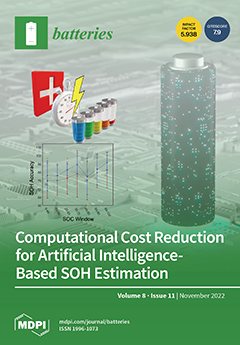Taking advantage of electrode thicknesses well beyond conventional dimensions allowed us to follow the surface plasmonic THz frequency phenomenon with vacuum wavelengths of 100 μm to 1 mm, only to scrutinize them within millimeters-thicknesses insulators. Here, we analyze an Al/insulator/Cu cell in which the metal electrodes-collectors were separated by a gap that was alternatively filled by SiO
2, MgO, Li
2O, Na
3Zr
2Si
2PO
12–NASICON, Li
1.5Al
0.5Ge
1.5(PO
4)
3–LAGP, and Li
2.99Ba
0.005ClO–Li
+ glass. A comparison was drawn using experimental surface chemical potentials, cyclic voltammetry (I-V plots), impedance spectroscopy, and theoretical approaches such as structure optimization, simulation of the electronic band structures, and
work functions. The analysis reveals an unexpected common emergency from the cell’s materials to align their surface chemical potential, even
in operando when set to discharge under an external resistor of 1842 Ω.cm
insulator. A very high capability of the metal electrodes to vary their surface chemical potentials and specific behavior among dielectric oxides and solid electrolytes was identified. Whereas LAGP and Li
2O behaved as p-type semiconductors below 40 °C at OCV and while set to discharge with a resistor in agreement with the Li
+ diffusion direction, NASICON behaved as a quasi n-type semiconductor at OCV, as MgO, and as a quasi p-type semiconductor while set to discharge. The capacity to behave as a p-type semiconductor may be related to the ionic conductivity of the mobile ion. The ferroelectric behavior of Li
2.99Ba
0.005ClO has shown surface plasmon polariton (SPP) waves in the form of surface propagating solitons, as in complex phenomena, as well as electrodes’ surface chemical potentials inversion capabilities (i.e., χ (Al) − χ (Cu) > 0 to χ (Al) − χ (Cu) < 0 vs. E
vacuum = 0 eV) and self-charge (ΔV
cell ≥ +0.04 V under a 1842 Ω.cm
insulator resistor). The multivalent 5.5 mm thick layer cell filled with Li
2.99Ba
0.005ClO was the only one to display a potential bulk difference of 1.1 V. The lessons learned in this work may pave the way to understanding and designing more efficient energy harvesting and storage devices.
Full article





